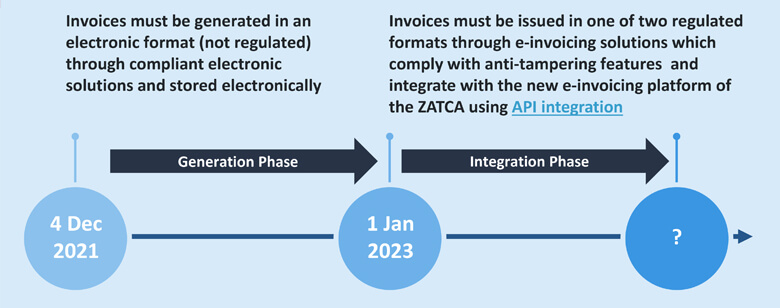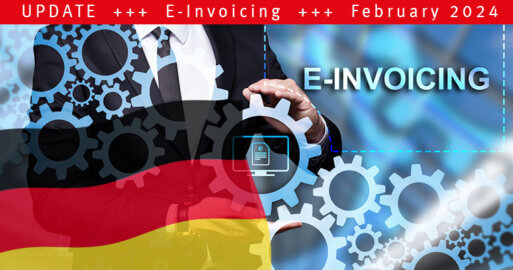Mandatory e-Invoicing in Saudi Arabia to be Phased In from 4th December 2021

Saudi Arabia’s General Authority of Zakat and Tax (GAZT) Arabia, which has since merged with the Customs Authority to become the Zakat, Tax and Customs Authority (ZATCA), published its finalized e-invoicing legislation on 28 May 2021. This makes e-invoices compulsory for B2B, B2G and B2C transactions, becoming effective in two phases:
- Phase one becomes effective on 4 December 2021
- Phase two is due to begin on 1 January 2023

This e-invoicing legislation had been under consultation since April 2021. However, apart from the start date of the second phase, which initially was set at 1 June 2022, not much has been changed.
The e-invoicing mandate in Saudi Arabia covers what is referred to as standard tax invoices (or standard invoices) and simplified tax invoices (or simplified invoices) and the debit or credit notes associated with each of these two invoice types.
- Standard tax invoices are used for B2B and B2G invoices.
- Simplified tax invoices are used in B2C transactions.
The legislation stipulates that anyone resident in Saudi Arabia for VAT purposes needs to create electronic invoices for domestic transactions. This does not apply to cross-border invoices or people non-resident for VAT purposes.
The exact requirements for the format, the content, security measures and CTC system varies by phase and for the 2 invoice types.
Saudi Arabia requires that these invoices are stored in an electronic format within the kingdom’s borders.
Phase 1 – the generation phase
Phase 1 of the e-invoicing legislation comes into effect on 4 December 2021. There will not yet be a central e-invoicing platform. Instead, the intention is that suppliers will move away from handwritten invoices and paper storage, and – of course – become prepared for Phase 2.
In phase 1, VAT-registered taxpayers need to
- generate invoices in an electronic format
- using an appropriate e-invoicing solution. This can be operated on-premises, in the cloud or in hybrid mode,
- store e-invoices electronically and
- send a copy of the invoice to the buyer.
During this phase, there are no specific stipulations on the electronic invoice format, as long as the content complies with the requirements of the standard invoice or simplified invoice. Simplified invoices for example, need to contain a Quick Response code (QR code), generated by the electronic e-invoicing system. QR codes enable consumers to scan in relevant invoice data using their mobile phones.
If you are just starting to introduce electronic invoices for Saudi Arabia, it would be prudent to implement one of the formats which will become mandatory in Phase 2.
The e-invoicing solution you use needs to fulfill certain security requirements, such as prohibiting uncontrolled user access or data manipulation, and making it impossible to reset the counter for sequential invoice numbering etc. However, at present it is unclear how and when the authorities might check and certify these anti-tamper measures.
Phase 2 – the integration phase
During the integration phase, your e-invoicing solution needs to be integrated with ZATCA’s new, central e-invoicing platform for Continuous Transaction Controls (CTC). There is a staggered start from 1 January 2023. Taxpayers affected by each stage will be notified six months in advance.
From phase 2 onwards
- Invoices must be issued in one of two stipulated formats
- Saudi Arabian XML invoice, which is based on UBL 2.1 syntax and the invoice definitions from EN 16931, but narrowed by Saudi Arabian requirements.
- PDF/A-3 invoice file with an embedded Saudi Arabian XML invoice (this is the same concept as ZUGFeRD in Germany and Factur-X in France, although the European examples use CII syntax while Saudi Arabia uses UBL syntax.)
- E-invoicing solutions must include certain anti-tampering features, such as a digital signature and a hash value as a universally unique identifier (UUID).
- Invoices need to go through ZATCA’s new e-Invoicing platform. This requires using API integration to connect your e-invoicing solution to the central platform.

In short
The Kingdom of Saudi Arabia is following the global trend in compulsory CTC e-invoicing and e-reporting. It is introducing a new clearance platform by 2023. During the initial preparation phase, starting 4 December 2021, e-invoices need to be generated through compliant e-invoicing systems and stored electronically.
The second stage will be rolled out from 1 January 2023. In this phase, the new central e-invoicing platform will start to become mandatory for real-time e-Invoicing clearance and e-reporting.
The challenge is – as always – to consider and implement each country’s individual legal requirements
- without having to deal with several different local providers in the countries involved,
- while ensuring you meet the various technical requirements for inbound and outbound invoicing, such as stipulated data formats and communication channels,
- and simultaneously maintaining an easy and reliable connection to the respective ERP systems.
How can SEEBURGER help?
The SEEBURGER BIS e-Invoicing solution lets you manage your incoming and outgoing invoices, as well as providing extensions for deep process integration within any ERP systems. This includes the seamless integration of SAP S/4HANA via the SAP API Business Hub. We are an established provider of cloud services with many years’ experience of understanding and meeting the various requirements in different countries in the EU and elsewhere with a single-source solution.
Webcast on-demand
Learn more about e-invoicing requirements and watch our webcast on-demand!
Thank you for your message
We appreciate your interest in SEEBURGER
Get in contact with us:
Please enter details about your project in the message section so we can direct your inquiry to the right consultant.
Written by: Gerrit Onken
Gerrit Onken has been at SEEBURGER since 2010 as a product manager for software applications and for electronic data exchange services for the business sector. He focuses on solutions for SAP, electronic invoicing (e-invoicing) and innovations for digitalizing business and technical processes for globally-active customers. Originally a banker, Gerrit Onken went on to graduate in business administration, majoring in industrial management and business informatics. After working in the financial sector, he worked as a manager and project manager from 2004 to 2010 for one of the top five corporate consultancies, working with international BPOs in the banking and automotive industries.





